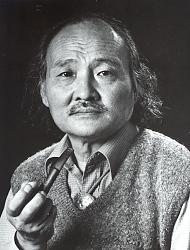|
His career as a painter began in Tokyo, the capital of
Japan. He got awards from the Kofukai, when the club invited
the young artists to join in a prize contest for best works in
1947. In the same year, he was more recognized by getting an
award from the Japanese National Arts Exhibition, sponsored by
the Ministry of Education, which was an authorized annual
exhibition in Japan. The second participation in the Kofukai
Exhibition allowed him to be awarded to golden prize and to be
spotlighted in the public. His connection with the Kofukai still
continues, by his taking part in their club.
The awards made his career and position firm in the
Japanese art world. In 1957, he returned to Korea, from his
experience in Japan, at the age of thirty one. Until then, he
could not have any acquaintance with artists in Korea, and was
not informed about the Korean art world.
His firm will made compete and stand in the Korean art
world, only with his artistic technique, pocketing his feelings
alone. He showed the inside of his art in Japan, through the
first exhibition, which was held in the year after his return at
the Whashin Department Store Gallery. People who were
impressed by the level of technique there expected his potential
for outstanding and affluent creativity. He held to his principle
to be devoted to his canvas by traditional painting awareness,
rather than to try to join new artistic trends from the West.
He, however, had tried to paint an abstract or semi-abstract
canvas, which implied modern plastic consciousness out of a
new observative attitude. This was around the time of his
return to Korea. Such attempts were shown in his first
exhibition in Korea and made a good contrast with his original
naturalism. That was the first and only trial. Since then, he
as made a clear adherence to the natural spirit.
Young Days in Japan
His young days's works, which preceded the elaborate and
emotional landscape paintings in Seoul, took their themes mostly
from man. Composition, color and touch of brush make
expressive canvases. Each of these works divulges the
outstanding.
'The Woman in a Beret' and 'The Woman Who Holds a
Mandolin', which brought the golden prize to him from the 1948
Kofukai Exhibition, are indoor, sedentary figures. Pose in
composition, expression of face and hands, use of color and
texture of touch make such works valuable and his capability
confirmed. After his winning the prize led him to be a member
of the Kofukai, he sent two exhibits, 'Rest' and 'The Man Who
Has a Violin', to the 1949 Kofukai Exhibition. Their touch and
color attracted people.
Two exhibits, 'Femme' and 'A French Lady' and 'A Woman'
which got a prize in the 1947 Japanese National Arts Exhibition
have his firm and investigating plasticity harmonizing the whole
mood of the canvas with the figures. The method was taught
by Terauchi Manjro, who was an outstanding academic realist
and was leading the Kofukai Club when Byun Shi Ji moved to
Tokyo after graduation from the Osaka Fine Arts School.
Terauchi Manjiro even wrote a recommendation when Byun Shi
Ji held his first exhibition in Tokyo in 1949. Mr. Byun's
winning in the Kofukai Exhibition might have had much help
from his teacher.
As I mentioned, Byun Shi Ji still participates in the Kofukai
Exhibition every year. He, on the other side, got many prize
from the Japanese National Exhibition and made his debut sure
before he returned to Korea. His efforts can be found in
'Portrait of Memo', 'A Lamp & a Woman', 'The Portrait of Mr.
K', 'A Man' and 'Three Nude Women'. The 'Three Nude
Women', which especially catches eyes, was formed realistically
but composed of different poses and countenanced, with soft
lines and unique composition in the coherence and change of red
tone. The canvas is very well framed and has the beauty of
plasticity. It may be considered his masterpiece of the 1950's.
Besides, one of his rare landscapes, 'Afternoon', which got a
prize in the 1950 Japanese National Arts Exhibition, has
calculated plasticity very correctly, taking its theme from a
factory scene with a contemplative view. It basically took a
horizontal composition, but building, wall and railroad are
emphasized in lines. The method which uniquely caught the
calm mood and time of summer afternoon appeared in 'A White
House & Black House' in 1946, with its sentimental view.
Those works of his young days were confirmed in Tokyo.
Soon, he brought the base to Seoul and tried this method in his
mother land.
Seoul Age and Biwon Series
Settling in Seoul, he devoted himself to landscape paintings,
which were about forests and lonely paths, as if he wanted to
fulfill his long nostalgia for the nature of his mother country.
He tried to give his canvas liveliness through light and
atmosphere, touching softly with eye and heart and describing
lonesome and desolate nature closely and in detail. That was
his return to an academic and realistic method. 'Road' which
was made in 1960 and 1961 reflects this attempt.
He did not mind the response of people about this method.
He believed that artistic creativity should be an unpretended
self-realization of an individual as an artist.
In 1960's, he had an opportunity to teach students of the
sorabol Arts College (former school of the Chungang Arts
College). Marriage with Lee Hak-suk, who majored in
Traditional Korean painting, gave him domestic peace and lively
activity. Until then, he went on with the academic and realistic
method. It was around 1963 that he was charmed with the
beautiful scenery and historical beauty of Biwon (Secret Garden)
and was absorbed in Biwon series.
He was alone in the central art world, which gave him
much time to be immersed in his work. The beauty and
historical meaning of Biwon touched the deep emotion of his
painting. Until he returned to Cheju Island and became a
professor, he continued to paint the color of Biwon for years.
The series are 'Autumn of Biwon', 'Pu-yong Arbor', 'Pan-
do Pond' 'Biwon', concerning U-hap Pavilion, 'Ae-yon Arbor',
and 'Biwon in the Autumn'. Besides, other old palace with
realistic sentiment and reappearance through painting. All of
them mirror his long nostalgia piled during his stay, in Japan,
of many years. He caught the scene of blue summer, colorful
autumn and white winter of Biwon, omitting only spring. He
might have thought that the blossom of flowers would deter the
soundless depth of a historical atmosphere. His canvas, what is
more, does not show any man. Only silence and calmness can
be found, which reveals his private heart and mind.
It is noticeable that some change appeared, about 1970, in
his canvas. He used more fresh and lucid colors. Unlike the
works painted before, scenes of summer and autumn were
emphasized by colorful beauty and liveliness of nature in 'Path
in Autumn' and 'Summer'.
Return to Cheju and New Self-realization
The landscape paintings of Biwon were exhibited in the
Shingi Club Exhibition and the Korean Art Club Association
Exhibition, where he became a member, and drew much
attention with thorough, realistic method. The method was
compared with landscape paintings of Mr. Son Eung-song, who
worked during the same period (He died in 1979).
When he returned to Cheju Island and got a job as a full
time instructor at the Department of Fine Arts Education in the
Cheju National University, he made another change of painting
method and expression. Exotic Cheju Island gave him different
emotion of painting. He found romantic and local scenes
everywhere. These soothed him and fulfilled his nostalgia. He
began to try a new technique out of affection. That was his
integrated and symbolic expression of love for his native island,
and a clear and impressed image different from the realism in
Seoul. It was really a change!
In fact, he kept on using the realistic method in Cheju
Island for a while. It was between 1976 and 1977 that he
suddenly changed his method into the traditional Korean
painting method. He absorbed his native island's beauty and its
unique life and took its symbols, such as blue sea and long
horizon, blue sky and clouds, black rocks and seashore, and
stone walls and thatched houses, into his canvas. Those began
his use of the oil painting method, like a traditional painting.
The first such use is shown in 'Sea Village', 'Io-do' and
'Summer in Cheju Island'.
Apart from the realistic description of objects, the realistic
use of color and the thorough objectivity, light yellowish brown
is covered on the whole canvas, and black or something like
that simply describes the concrete objects of a scene. This
unrealistic and plain method confirms him as a local romanticist.
He still loves the yellow and black colors. Limited natural color
of yellowish brown and black lines as well as the extremely
simple development of theme make the scenic beauty of Cheju
Island seem dense. He is creating the very art which can only
be made by a true artist of Cheju Island.
It is also noteworthy that he depicts native ponies, cows,
and people of Cheju into canvas to introduce life to the scenic
beauty of Cheju. What is more, another man with a stick
appears in the canvas, who is not a farmer or a fisherman, but
himself. That is, to describe himself, because it can be clearly
explained if we notice a man painting a picture in a small
thatched house standing between the sea and a hill.
Introduction of the Oriental Painting Spirit
Byun Shi Ji produced a lot of works, traveling the Europe
in 1981. He moved onto his canvas, in a series, his impression
of a journey to Italian cities such as Rome, Firenthe, Venezia,
Pompeii and Napoli, as well as to Paris and London. His
method follows the style used in Cheju Island, the same black
lines on the yellowish brown canvas. Here, though, the lines
gave relative importance to the situation. Again, a man with a
stick shows himself on the canvases. His appearance results
from his complex psychology.
His naive canvas, consisting of pure forms, does not give
out any unnatural elements. As time goes by, his artistic
inclination seizes me with its uniqueness. First of all, the black
lines, which are originated from the traditional painting and
produced heterogeneous taste with oil colors, are results of his
creativity.
When he returned to Korea from Japan, he said in an
interview that.
"I came back because I felt that I should establish my are
on the national basis, getting older."
Leaving for Cheju Island, he joined with some advocates
the Oriental Art Club, which aimed to revive a traditional
Oriental style, and led it for years. That shows his will to
realize the Oriental painting spirit, through oil painting. At that
time he began to try traditional painting in India ink. It is very
helpful to understand him through all his surroundings.
|

